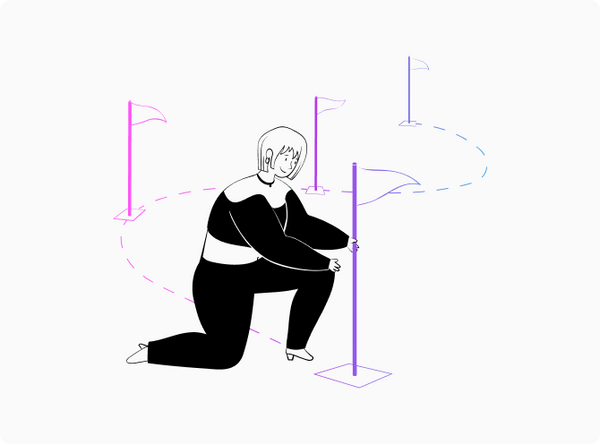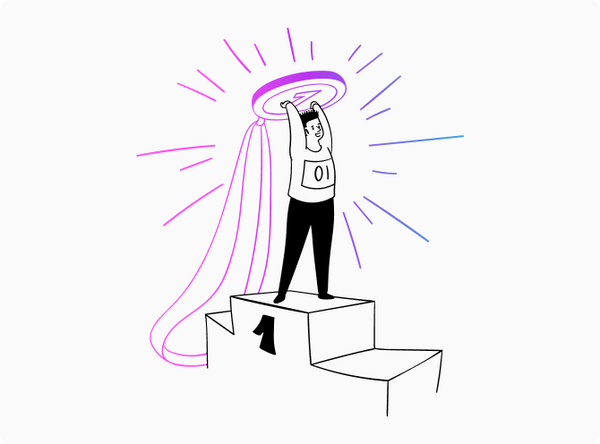
Bringing a business idea to life requires a combination of planning, design, development, testing, and iteration. Some companies try to do everything all at once and fail to deliver a quality product; others simply get overwhelmed by the number of development stages and don't make it to the release date.
However, there are startups like Uber, Spotify, and Airbnb that have successfully launched their products, and eventually made them profitable. Most of them started their journey with the development of MVPs. In this article, we'll explain what an MVP is and how it can help turn your business ideas into a fully-functional product.
What is MVP, and How Will it Help for Product Development
The acronym MVP stands for the 'Minimum Viable Product'. It is a concept used in product development to describe the basic version of a product with just enough features to attract early adopters (users) and gain their feedback for future improvements. It is a powerful tool that helps startups test their market assumptions while also minimizing the investments that need to be made in the project.
What Is the Purpose of MVP Development Process
Aside from cost reduction, MVPs allow companies to get the product to market faster. Once the MVP gets released, companies can start collecting user feedback to understand a) to which extent the product meets market demand and b) what needs to be improved or changed. By doing so, companies better understand customer needs and preferences and prioritize the following product development.

MVP Design Process Principles
There may be many activities involved in the MVP building process; however, to keep the project on track we always recommend focusing on the four main principles during the MVP process:
- Idea validation — you're developing an MVP to validate a specific idea or test assumption.
- Rapid development — the development of an MVP shouldn't take years. In the ideal case 2 to 4 months max.
- Cost-efficiency — all MVPs should be cost-effective because there's no reason to invest heavily in an idea that may not work out, or doesn't gather enough demand.
- Quick iterations — after getting customer feedback about your MVP, it's important to adjust your product quickly to maintain interest in the product among the target audience.
How to Plan Your MVP Building Process Effectively
Define product purpose
The first step in the agile MVP process is defining the product's purpose. During this planning process for developing MVP, you want to find a specific problem that users currently have and determine how your product can solve it. Chances are that during your research you may come across different users' pain points. The goal here is to prioritize them based on their importance and the impact they produce. This will not only help to ensure that your MVP focuses on solving the most critical problem first but also will narrow down the list of features that you might want to include in your product later on.
Research the market
Aside from understanding the main user problem, it's also necessary to be aware of what's happening in your industry, what competitors are doing, and what’s currently trending. For one, this information will give you a competitive edge allowing you to come up with a product that takes into consideration what current offerings are lacking. On the other hand, however, it will help you avoid common mistakes made by competitors and ensure users find in your product what they're looking for.
Define the feature set
Based on the research you've done so far, create a list of features that are necessary to solve the user problem you’ve identified. Make sure to keep it limited to the most essential (core) features. Consider also how they will interact with each other technically, and how they will contribute to the general user experience.
Prioritizing your MVP feature set may look cumbersome at first glance; however, there are a few techniques that you can use to pick those that fit your product best. Check out this article for more information: How to Choose Features for Your MVP: the Best Methods to Follow.
Develop and launch prototype
This is the stage where all the technical side of the process of building a minimum viable product should be carried out by your team. It's important that you have programmers with the expertise relevant to your industry. They need to deliver your project in a timely manner and within the projected budget. If you don't have an in-house team, you can always opt for outsourcing software development services that are more affordable than in-house development.
Once your MVP is ready to be launched, consider ways of promoting it. You can do it via landing pages, ad campaigns, explainer videos, collaborating with bloggers, and so on. For more details check the article 12 Proven Ways for Testing Your MVP on our blog.
Iterate
Developing an MVP is only part of the process. After it goes live and you start testing it on your target users, collect their feedback to find out which improvements should be made. In fact, this stage may last as long as your product stays on the market because, for one, you may decide to enhance the MVP's functionality and need new updates to be rolled out. The user preferences may also change over time, which means your product should be adjusted accordingly.

In What Cases You Shouldn't Build an MVP
There are some cases when it’s better to avoid building an MVP, or at least give it a second thought before starting. As with any other project, with the lack of subject knowledge, an MVP might turn out to be a waste of time and resources, or it might not perform as expected. Here are three scenarios showing when this might be the case.
When you don't understand the problem
It is essential that you have a complete understanding of the problem you are trying to solve before you proceed to create an MVP. If you don’t understand what functionality users expect to get, an MVP most definitely won't be able to generate high interest and produce high returns. So, take the time to conduct market research and talk to potential clientele to gain an understanding of the problem and how best to solve it.
When it is a barely functioning product
Creating an MVP does not mean just releasing a barely functioning product. It is important to ensure that your MVP has enough features to properly serve its purpose. So, if you haven't enough resources to ensure that your product is stable and able to provide enough features to your users, then it's better not to start the MVP building process.
When there's already a product for your idea
If there is already a product that solves the same problem that you target, there's no need to jump into MVP development. Instead, go back to the drawing board and assess how you can make your product better or different. Think about how you can adjust your idea or business concept to stand out from the competition.

Consider Some Best Practices for Creating an MVP
Clear goal is a must
Before starting to work on the MVP, it's important to set a clear and specific goal for your project. A clear understanding of what you're aiming for will help to better define the MVP process flow, prioritize your development efforts and allow you to reduce the overall time and costs needed to complete your project.
In a nutshell, a clear goal provides a direction for you and your team, and without it, any project risks falling into neverending iterations, micromanagement chaos, and direction changes that happen faster than the team is able to adapt to them.
Have your business plan right from the start
Having a business plan helps to identify potential risks and opportunities that may take place after your MVP goes live. Aside from that, a business plan also outlines your target market, defines the marketing strategy of your MVP, and guides the development process as a whole. In other words, if the goal of your project establishes a general direction, the business plan defines the technical/practical means of achieving this goal.
Additionally, a business plan is essential when seeking investors or partners for the MVP. It allows them to see a roadmap for your project in terms of development, marketing, and distribution.
Prioritize
During an MVP product development process, you want to ensure that you utilize available resources in the most effective manner. This is why it's of the utmost importance to set priorities and not try to do everything at once.
In addition to prioritizing resources and MVP functionality, clear priorities will allow you to manage expectations and bring everyone on the team onto the same page regarding where the MVP development process is heading, what needs to be integrated at each specific point, what the next MVP process phases are, and so on.
Keep bigger picture in mind
While MVPs are mainly focused on testing business ideas, by no means should they be considered static products. Developers shouldn't focus solely on the short-term gains, but think about how their MVP could evolve over time, and what should be done to improve and further enhance it over time. This will help ensure that the MVP remains relevant and up-to-date with the needs of the target audience.

How to Know if Your MVP is Successful
The success of your MVP will depend on the specific goals and requirements that you set for your project. So, you need to set specific criteria — or metrics — and evaluate your MVP against them. These criteria can be either of qualitative or quantitative nature.
Qualitative metrics offer more of a subjective opinion, but they can give you access to a wider perspective and help assess how users interact with your MVP in general. The main criteria here are user feedback, user engagement, user experience, and user behavior.
Quantitative metrics are connected to concrete measurements that help to objectively assess the performance of the particular feature, webpage, or UI. Here we're talking about Conversion Rate (CR), Customer Acquisition Cost (CAC), Retention Rate (RR), Time on Page, Session Duration, and so on.
By utilizing both qualitative and quantitative metrics, you can gain a more comprehensive understanding of how your MVP is performing and identify opportunities to improve it.
Lunka.tech Experience in Building MVP Development Process
At Lunka.tech, we understand that every business may have unique needs, and that's why we offer a range of services in different niches and for different types of products — all to help businesses achieve their specific goals.
Our services include — but are not limited to — MVP development for startups, custom mobile app development, web development, devOps services, and more. We utilize the latest technologies and programming languages to deliver high-quality, scalable software solutions that meet our clients' requirements.
If you're interested in checking the projects (MVPs included) that our team has worked on, we encourage you to check out our portfolio, which we update regularly.

Final Thoughts
Launching your product can quickly become a daunting task, especially if you have no prior experience in this area. However, developing an MVP can greatly ease the process, help test your business concepts, and get customer feedback fast. All without investing too much time and money into the development.
If you are starting to build an MVP, following the above steps and tips will better prepare it for launch and minimize the associated risks. If you want to get more information on the MVP process meaning, or are simply looking for a reliable software development partner, fill out a feedback form and we'll get in touch with you ASAP!
FAQ
How much the development of an MVP might cost?
The cost of developing an MVP can vary depending on the complexity of the product, the number of features, the technology stack, the location of the development team, the level of experience of the developers, etc. The cost may sit anywhere between $5,000 and $50,000 depending on the specific requirements. Keep in mind that these numbers are just general guidelines, and if you need an actual estimate for your project, contact our managers directly.
What technologies do you use for building MVP?
The tech. stack that we use depends on project requirements and the type of the product. In general, though, our team works with such technologies as Swift, .NET, Django, React, JavaScript, Python, and more.
What are the main benefits of MVP?
Building an MVP allows you to test market assumptions and validate your business idea before investing significant resources in the development of a fully-fledged product. MVPs help companies to save on resources and increase the chances of success for their product concept.
Do I need to outsource the development of an MVP?
It all depends on whether you want to create your MVP in-house or not. If you want everything to be done by an in-house team, that's fine — just make sure your programmers have the needed know-how for carrying out such projects. If you don't have an in-house team, then outsourcing would be the most viable option as it will help you to save your budget and launch your MVP quickly.



